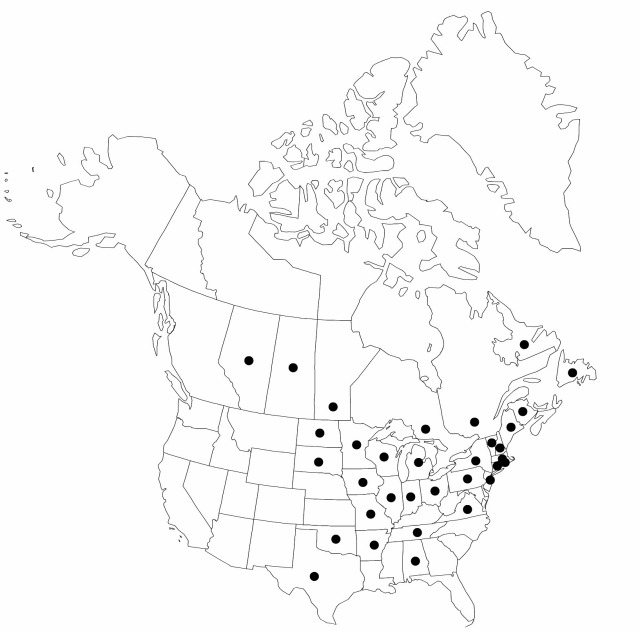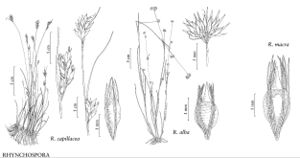Difference between revisions of "Rhynchospora capillacea"
Fl. N. Middle United States 1: 55. 1823.
FNA>Volume Importer |
imported>Volume Importer |
||
| (4 intermediate revisions by 2 users not shown) | |||
| Line 8: | Line 8: | ||
}} | }} | ||
|common_names=Rhynchospore capillaire | |common_names=Rhynchospore capillaire | ||
| + | |special_status={{Treatment/ID/Special_status | ||
| + | |code=F | ||
| + | |label=Illustrated | ||
| + | }}{{Treatment/ID/Special_status | ||
| + | |code=E | ||
| + | |label=Endemic | ||
| + | }} | ||
|basionyms={{Treatment/ID/Basionym | |basionyms={{Treatment/ID/Basionym | ||
|name=Rhynchospora setacea | |name=Rhynchospora setacea | ||
|authority=(Muhlenberg) MacMillan | |authority=(Muhlenberg) MacMillan | ||
| + | |rank=species | ||
|publication_title= | |publication_title= | ||
|publication_place=1892 | |publication_place=1892 | ||
| Line 17: | Line 25: | ||
|name=Phaeocephalum capillaceum | |name=Phaeocephalum capillaceum | ||
|authority=(Torrey) Farwell | |authority=(Torrey) Farwell | ||
| + | |rank=species | ||
}} {{Treatment/ID/Synonym | }} {{Treatment/ID/Synonym | ||
|name=Triodon capillaceus | |name=Triodon capillaceus | ||
|authority=(Torrey) Farwell | |authority=(Torrey) Farwell | ||
| + | |rank=species | ||
}} | }} | ||
|hierarchy=Cyperaceae;Rhynchospora;Rhynchospora capillacea | |hierarchy=Cyperaceae;Rhynchospora;Rhynchospora capillacea | ||
| Line 44: | Line 54: | ||
-->{{#Taxon: | -->{{#Taxon: | ||
name=Rhynchospora capillacea | name=Rhynchospora capillacea | ||
| − | |||
|authority=Torrey | |authority=Torrey | ||
|rank=species | |rank=species | ||
| Line 58: | Line 67: | ||
|publication title=Fl. N. Middle United States | |publication title=Fl. N. Middle United States | ||
|publication year=1823 | |publication year=1823 | ||
| − | |special status= | + | |special status=Illustrated;Endemic |
| − | |source xml=https:// | + | |source xml=https://bitbucket.org/aafc-mbb/fna-data-curation/src/2e0870ddd59836b60bcf96646a41e87ea5a5943a/coarse_grained_fna_xml/V23/V23_367.xml |
|genus=Rhynchospora | |genus=Rhynchospora | ||
|species=Rhynchospora capillacea | |species=Rhynchospora capillacea | ||
Latest revision as of 20:40, 5 November 2020
Plants perennial, cespitose, 10–40 cm, wiry; rhizomes stoloniferous, slender, to 1.5 mm thick. Culms erect or curved, leafy, filiform, angularly fewribbed. Leaves ascending-excurved, overtopped by culm; blades filiform, involute, apex setaceous. Inflorescences: spikelet clusters 1–2(–3), often sparse, ellipsoid or narrowly turbinate, less than 1 cm wide; subtending foliaceous bracts exceeding compounds. Spikelets erect or ascending, pale redbrown to brown, fusiform, 6–7 mm; fertile scales elliptic, 4 mm, apex rounded or acute, midrib shortexcurrent or not. Flowers: perianth bristles 6, overtopping tubercle base, mostly retrorsely barbellate, sometimes smooth [forma laeviseta (E. J. Hill) Fernald]. Fruits 1–4(–5) per spikelet, 2.5–3 mm; body pale brown, slender stipitate, ellipsoid, lenticular, 1.5–2 × 0.8–1 mm; surfaces longitudinally minutely striate, obscurely transversely lowrugose, dotted; tubercle narrowly triangularsubulate, flattened, 0.8–1.7 mm.
Phenology: Fruiting summer–fall.
Habitat: Moist to wet calcareous fens, seeps over limestones or calcareous rock, marsh meadows
Elevation: 0–1000 m
Distribution

Alta., Man., N.B., Nfld. and Labr., Ont., Que., Sask., Ala., Ark., Conn., Ill., Ind., Iowa, Maine, Mass., Mich., Minn., Mo., N.H., N.J., N.Y., N.Dak., Ohio, Okla., Pa., R.I., S.Dak., Tenn., Tex., Vt., Va., Wis.
Discussion
The two beakrushes most commonly occurring in fens are Rhynchospora capillacea and R. capitellata.
Selected References
None.
